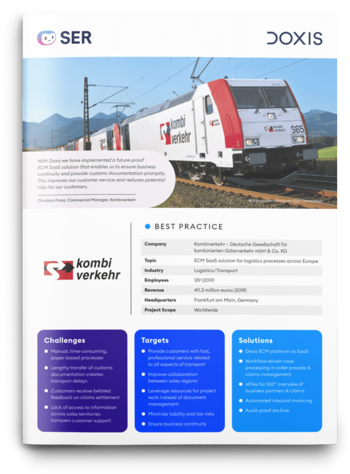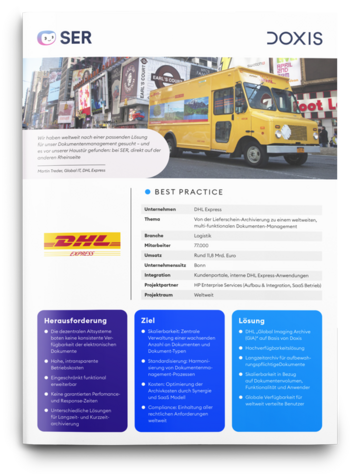SER Blog Customer Stories & Use Cases
Digital consignment notes: All about workflows for CMR notes
Since 1956, the CMR consignment note has served as a standard solution for documenting international shipping of goods, which, in addition to liability issues, also regulates other rights and obligations for all the parties involved. This article provides an overview of these rules and looks at the impact of CMR regulations on the shipping sector today.

What is a consignment note?
The consignment note is a document accompanying the goods that contains important information about the sender (client), recipient, carrier and the goods being transported. It serves as proof of the freight contract, as well as confirming acceptance and delivery of the goods.
Consignment notes are used in different modes of shipping freight: in road freight transport by truck, in rail freight transport by train, in air freight transport by plane and in inland and sea shipping.
CMR consignment notes
A CMR consignment note is a standardized transport document that must be issued and carried when shipping goods internationally by road. It is based on the CMR agreement – the abbreviation CMR stands for “Convention relative au contrat de transport international de marchandises par route,” which translates loosely to "convention on the transport contract in international road freight transport."
The aim of the agreement is to create standard terms and regulations for international road freight transport and facilitate cross-border transport of goods.
Countries participating in the CMR agreement
The CMR agreement was signed in 1956, and the CMR consignment note has been mandatory in Germany since 1962. Fifty-six countries have now signed the agreement, including all EU states, Great Britain, Russia, Morocco, Tunisia, Iran, Switzerland, Turkey, Ukraine and many more.
What distinguishes a CMR consignment note from other consignment notes?
The CMR consignment note is a special form of consignment note that applies to international road freight transport. The CMR agreement takes effect as soon as goods are transported across national borders and one of the two countries (shipping or destination) is a member of the agreement.
Purpose of CMR consignment notes
The CMR consignment note serves three main purposes:
Information
It contains all the important information describing the freight, including type, quantity, and weight of the goods, number of packages, and labeling of the goods. In addition, the consignment note records the transport and freight costs, the date and place of acceptance, as well as the planned date and place of delivery. It also provides information (name, address) about the sender, recipient and carrier, as well as other agreements, notes, and conditions.
Proof
The CMR consignment note is intended to reduce risk during transport. It provides proof of the freight contract between the sender and the carrier. In addition, it proves that the carrier has fulfilled its obligation to properly check the transported goods – condition, packaging, quantity and labeling – before transport.
Receipt
The consignment note is therefore also a receipt for the correct number and identification of the freight items. It confirms the acceptance and receipt of the goods by the carrier.
In addition, a correctly completed consignment note simplifies customs formalities and helps to settle freight and transport costs.

Automatically manage shipping documents
Find out how an ECM system is helping Kombiverkehr improve and accelerate its logistics processes across Europe.
Read the case study nowWhy do I need a consignment note?
The consignment note is a legally binding document that provides evidence of the transport order. It also defines and documents the rights and obligations of the parties involved, determines conditions of transport, and regulates liability issues.
Importance of international uniformity in freight transport
International standards in freight transport make it easier to transport goods across national borders and facilitate trade between countries. Thanks to the standardized CMR consignment note, international transport and customs clearance run much more smoothly and efficiently, reducing labor and costs.
In addition, compliance with international standards and regulations ensures greater safety. It ensures that the goods are properly packaged, labeled, and transported.
Legal background and regulations
The legal basis for consignment notes can be found primarily in the regulations of the respective country. In Germany, important regulations include the commercial code (HGB) and the ADSp (German Freight Forwarders’ General Terms and Conditions).
For international transport, the CMR agreement takes precedence over national regulations – as long as one of the countries involved is a member. This is the case, for example, if you ship from Germany to another country or transport goods to Germany from abroad. If the CMR regulations are not relevant in individual cases, then the national laws apply again.
Carrying the CMR consignment note is usually mandatory, in contrast to national freight transport. According to the 1998 reform of German transport law, accompanying documents such as delivery notes and delivery lists are sufficient for domestic German transport traffic. However, the carrier may require a consignment note to be issued (§ 408 HGB).
Liabilities regarding consignment notes
In principle, freight forwarders and drivers are obliged to transport the goods to their destination safely and undamaged. During transport, all relevant regulations regarding load securing, road traffic regulations, and similar must also be observed.
CMR consignment notes also clarify liability issues, as well as the complaint and limitation periods, and regulate the risks and responsibilities in the context of the transport of goods, including:
- The sender is responsible for ensuring that the CMR consignment note is filled out correctly and completely. The sender is liable for the information.
- The carrier is liable, regardless of fault, for all losses and damage that occur during transport between acceptance of the goods and delivery, as well as for delays. Limitations of liability are regulated in Article 23 Number 3 CMR.
- The recipient is obliged to confirm receipt of the goods. If there is any damage or loss, this must be reported immediately.
Completing the CMR consignment note – here’s how
As a rule, the sender issues the CMR consignment note. This must be in French or English. There are no further requirements regarding format; the CMR regulations only define requirements for content. You can find a range of forms online and available commercially that you can use. It is important that you fill out the freight document truthfully, clearly, in legible writing, and absolutely correctly.
The consignment note has to be issued in at least three copies, all of which must be signed by sender and carrier. The sender keeps one copy, another is intended for the carrier, and the third copy accompanies the goods to the recipient.
Digital consignment notes: Benefits of the e-CMR
In 2008, the CMR agreement was supplemented by an additional protocol regarding the e-CMR. This means that it is now also possible to create a CMR consignment note in electronic format. According to the International Road Transport Union (IRU), 34 countries have currently signed the additional protocol and codified the carrying of digital consignment notes in national law. This means that the digital consignment note is only valid in these countries.
In Germany, the contracts law “concerning the electronic consignment note” has allowed for use of CMR consignment notes in electronic format since 2021.
Benefits of digitalization in transportation
The digitalization of CMR consignment notes has many benefits:
- Carriers and drivers no longer have to carry paper consignment notes, which are easily lost, filled out by hand, and sometimes not easy to read. Instead, the e-CMR is always available via onboard computer, smartphone, tablet, or other device.
- Classic paper consignment notes are very prone to errors. Digital processes help to complete the paperwork accurately and completely.
- The e-CMR enables digital documentation of freight in real time. The status of the delivery can be tracked at all times, and proof of delivery is available immediately. The CMR is digitally signed and can be shared directly with everyone involved.
- There is a significant increase in efficiency in transport. Orders are processed faster and all parties involved work together smoothly and digitally.
- The reduced administrative effort saves you costs.
- Digitalization conserves paper resources and contributes to greater sustainability.
How digital consignment notes work
- The sender creates the digital consignment note and signs it electronically.
- The digital consignment note is transmitted automatically to the e-CMR platform.
- The e-CMR platform makes the signed consignment note available to all parties involved in the supply chain.
- The driver receives the digital consignment note on their smartphone or tablet, and has mobile access to all information during the transport.
- The driver updates the status of the delivery in real time.
- The recipient opens the digital consignment note on their device and can view the delivery information.
- Upon delivery, the recipient acknowledges receipt digitally.
Note: Learn more in our glossary about electronic signatures, the different types, benefits, and how they work.
Manage digital consignment notes via ECM
The right software is a prerequisite for smoothly processing and managing digital consignment notes. With an enterprise content management (ECM) system you can bring order to your freight documents and build automatic workflows around your consignment notes:
- As a comprehensive document management system (DMS), the ECM supports you in managing large amounts of documents, tagging them, and storing them in the proper electronic files. This means the information is always easy to find.
- You reproduce all the documents related to special processes, customers, and orders centrally on one platform. You can merge all the relevant information using suitable interfaces to third-party systems such as CRM and ERP platforms, and this helps you, for example, when completing CMR consignment notes.
- With the ECM you automate your workflows and link specific events with tasks and follow-up processes. For example, the responsible employee automatically receives a message when the consignment note is signed or the delivery date is automatically stored in the ERP system. The workflows can be configured individually as required.
- Mobile ECM versions enable freight drivers to provide real-time information, digitally sign and acknowledge consignment notes, and easily communicate with other parties in the supply chain.
- Consignment notes have a retention period of six years. In the ECM system you can digitally archive your freight documents in a legally secure manner.

Best Practice: Managing complex supply chains seamlessly
Find out how DHL Express used Doxis to create one of the biggest commercial document archives in the world.
Read nowDigital CMR consignment notes are the future
The CMR agreement and digital transformation are making international transport far easier. The uniform regulations, digitalized processes, and automation options make trade between countries and collaboration between all those involved in the supply chain much more efficient, faster and cheaper.
The European Union supports this development and plans to make the digital CMR consignment note mandatory across the EU starting in 2026. Then you can benefit from the advantages of electronic freight documents throughout Europe.
Frequently asked questions about CMR consignment notes
The latest digitization trends, laws and guidelines, and helpful tips straight to your inbox: Subscribe to our newsletter.
How can we help you?
+49 (0) 30 498582-0Your message has reached us!
We appreciate your interest and will get back to you shortly.




